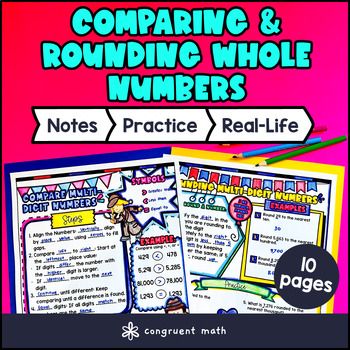Want more ideas and freebies?
Get my free resource library with digital & print activities—plus tips over email.
Join for Free Resources →
$4.25
Ever wondered how to teach comparing and rounding whole numbers to your 4th and 5th grade students in an engaging way?
In this lesson plan, students will learn about comparing multi-digit numbers and rounding to any place value, along with their real-life applications. Through artistic, interactive guided notes, checks for understanding, a doodle & color by number activity, and a maze worksheet, students will gain a comprehensive understanding of these number skills.
The lesson ends with a real-life example that explores how comparing and rounding numbers are used in event planning and construction scenarios.

$4.25
After this lesson, students will be able to:
Before this lesson, students should be familiar with:
As a hook, ask students why it might be important to compare large numbers and round numbers to a certain place value in everyday life. For example, why do people round prices when shopping or compare scores in a game? Refer to the last page of the guided notes as well as the FAQs below for additional real-life examples and ideas.
Use the first page of the guided notes to introduce comparing multi-digit whole numbers. Walk through how to compare numbers by looking at the digits from left to right, identifying which place values are different, and deciding whether to use the greater than (>), less than (<), or equal to (=) symbols. Emphasize key points such as aligning the place values, then starting comparisons with the highest place value and what to do when digits are the same. Refer to the FAQ below for a detailed walkthrough and suggestions on responding to common student misconceptions, such as confusing the symbols or not aligning place values properly.
Use the second page of the guided notes to introduce rounding whole numbers to any place value. Teach the steps of identifying the digit to round to, looking at the digit immediately to its right, and deciding whether to round up or down based on whether that digit is 5 or greater. Highlight examples rounding to various place values such as thousands, hundreds, tens, and ones. Stress why rounding is useful and how it simplifies numbers while keeping them close to the original value. Refer to the FAQ below for a step-by-step explanation and strategies to support students who struggle with identifying the correct digit or determining when to round up or down.
Based on your students’ responses to the guided notes and checks for understanding embedded in each page, reteach any concepts where students show confusion or not yet mastery. For classes with mixed proficiency, consider pulling small groups aside for targeted reteaching on comparing symbols or rounding rules, while advanced students can begin working independently on the practice exercises.
Have students practice comparing and rounding whole numbers to any place value using the maze worksheet included in this resource (page 4). Walk around to answer student questions.
Fast finishers can start the color by number activity included in this resource (page 5) for extra practice. You can assign it as homework for the remainder of the class.
Bring the class back together, and introduce the concept of using comparing and rounding whole numbers in real-life scenarios such as event planning and construction projects. Discuss how professionals need to compare quantities and round measurements to estimate costs, materials, or timelines accurately. Use examples from the provided application worksheet to help students see the practical use of these math skills in everyday life. Refer to the FAQ for more ideas on how to teach it!
If you’re looking for digital practice for comparing and rounding whole numbers, try my Pixel Art activities in Google Sheets. Every answer is automatically checked, and correct answers unlock parts of a mystery picture. It’s incredibly fun, and a powerful tool for differentiation.
Here are 4 activities to explore:
Comparing whole numbers means determining which number is larger, smaller, or if they are equal by looking at their digits starting from the highest place value.
To compare multi-digit numbers, you align the place values of the two numbers. Then, start by comparing the digits in the highest place value and move right until you find a difference.
The symbols used to compare numbers are:
To round a whole number to any place value, follow these steps:
Rounding simplifies numbers to make them easier to work with, especially in estimation, real-life measurements, and calculations.
Place values determine the value of each digit in a number and help to accurately compare and round numbers by focusing on the correct digit.
Rounding up happens when the digit right after the target place is 5 or greater, so the rounding digit increases by 1. Rounding down happens when that digit is less than 5, so the rounding digit stays the same.
Yes, numbers with different digit lengths are compared by place value. The number with more digits usually is greater if the higher place values differ.
Get my free resource library with digital & print activities—plus tips over email.
Join for Free Resources →